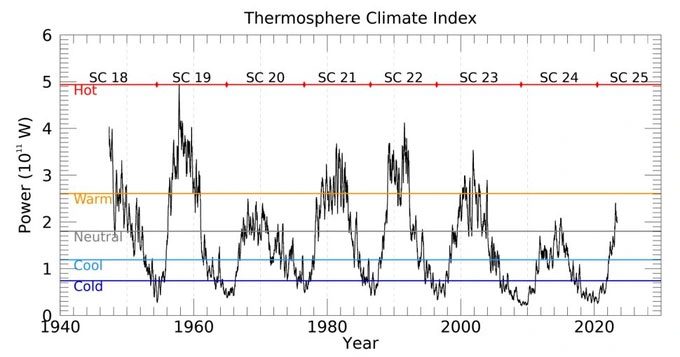Recent geomagnetic storms have caused a significant spike in Earth’s atmospheric temperatures, reaching the highest levels in the past 20 years.
According to Space reports, Earth’s atmosphere has recently set a new temperature record after absorbing energy from intense solar storms (or geomagnetic storms) that have been active in recent times.

The spectacular aurora phenomenon occurring in Earth’s sky signals that we are experiencing solar storms. (Photo: Shutterstock).
Martin Mlynczak, a researcher from the TIMED mission at NASA’s Langley Research Center, stated: “The Thermospheric Climate Index (TCI) spiked on March 10, reaching a peak of 0.24 TW (Note: 1 TW is equivalent to 1 trillion watts).” It is noted that the last time the TCI was this high was on December 28, 2003.
According to this expert, the surge in Earth’s atmospheric temperature is due to three geomagnetic storms that occurred in January and February. These storms caused significant disturbances to Earth’s magnetic field.
Mlynczak explained that these storms accumulate energy in the ionosphere and then heat it up due to the increased levels of infrared emissions from nitric oxide and carbon dioxide.
Typically, infrared radiation following a solar storm cools the ionosphere, but due to the consecutive storms, temperatures have remained high without decreasing.
Since the atmospheric temperature spiked, there have been at least two more geomagnetic storms that have impacted our planet. One storm occurred on March 24, marking the strongest storm to hit Earth in over six years. Another storm took place on April 24.

The chart shows TCI values rising and falling with each strong solar activity cycle. (Photo: NASA).
Scientists from the National Oceanic and Atmospheric Administration (NOAA) have predicted that the next solar maximum will occur in 2025.
This means that the trend of rising atmospheric temperatures may continue for the next few years, potentially affecting the operations of satellites orbiting Earth.
“The thermosphere expands as it warms, leading to increased aerodynamic drag on all satellites, as well as debris in space,” Mlynczak explained. “This could pull satellites closer to Earth, causing them to collide with each other or drift out of their intended orbits.”
A similar situation occurred with SpaceX’s Starlink satellites in February 2022 following an unexpected geomagnetic storm.
- The mini electric vehicle just launched has caused a sensation: Size of VinFast VF 5, can travel more than 560km on a single charge
- Why does a transparent case turn yellow after some time of use?
- The only antique in the world that cannot be faked or replicated, its magical qualities are comparable to “deities”


















































